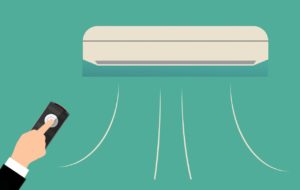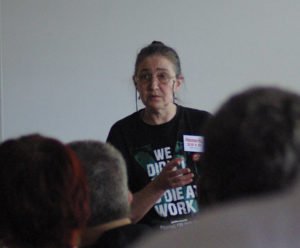The HSE has reviewed its ventilation and Air Conditioning guidance, which states that employers must make sure there is an adequate supply of fresh air (ventilation) in enclosed areas of the workplace.
The guidance says,  maximising the fresh air in a space can be done by:
maximising the fresh air in a space can be done by:
- Natural ventilation which relies on passive air flow through windows, doors and air vents that can be fully or partially opened.
- Mechanical ventilation using fans and ducts to bring in fresh air from outside.
- A combination of natural and mechanical ventilation, for example where mechanical ventilation relies on natural ventilation to maximise fresh air.
The HSE has reviewed its guidance, which will apply in most workplaces, with the aim to help employers and their workers to:
- Assess the risk from aerosol transmission in enclosed areas.
- Identify poorly ventilated areas.
- Decide on the steps to take to improve ventilation.
Ventilation is important because adequate ventilation reduces how much virus is in the air. It helps reduce the risk from aerosol transmission, when someone breathes in small particles (aerosols) in the air after a person with the virus has been in the same enclosed area. The risk is greater in areas that are poorly ventilated.
Ventilation reduces the aerosol risk but has minimal impact on:
- Droplet transmission (where people are within 2 metres of each other).
- Contact transmission (touching surfaces).
The guidance acknowledges that adequate ventilation can look different in different workplaces or settings.
The risk of aerosol transmission can be reduced by:
- Making sure infected workers (or any visitors with coronavirus symptoms) do not come into the workplace.
- Providing adequate ventilation with fresh air.
- Limiting the number of people in an area.
- Thinking about activities that increase deeper breathing (including singing, physical exertion and shouting).
- Workers spending less time in occupied areas.
A risk assessment should consider what adequate ventilation looks like in a particular workplace.
Read the HSE’s, Ventilation and air conditioning during the coronavirus pandemic guidance, here.
Limiting transmission
In a article written in February for LocalGov, Hywel Davies – Technical Director of the Chartered Institution of Building Services Engineers (CIBSE) – suggested that focus in workplaces and multi-occupant spaces, especially those open to the public, must remain on limiting transmission to prevent the spread of coronavirus to un-vaccinated people.
The article highlighted advice from the Government’s Scientific Advisory Group for Emergencies (SAGE) in its document Role of Ventilation in Controlling SARS-CoV-2 Transmission, which is that: ‘Ventilation should be integral to the COVID-19 risk mitigation strategy for all multi-occupant public buildings and workplaces.’
Hywel argued that the need for effective ventilation in helping limit the spread of COVID-19 is based on growing evidence that coronavirus can be spread by tiny particles called aerosols.
The acts of breathing, talking, coughing and sneezing all produce droplets and aerosols that may, if the host is infected, contain pathogens. Larger droplets fall by gravity within 2m from the source, which is why social distancing is recommended. The droplets land on surfaces and can therefore get onto hands – hence the importance of regular hand washing and avoiding touching the face. Smaller aerosols, however, can stay airborne for hours, which enables them to travel longer distances where they could infect secondary hosts, particularly in poorly ventilated spaces.
Investment
 Hilda Palmer, from Manchester Hazards Centre, a campaigner and facilitator of Families Against Corporate Killers and SHP’s Most Influential Individual in Health & Safety for 2020, told SHP in May: “Ventilation in most of our workplaces has been poor for many years and workers have been complaining about the levels of dust and microbes, volatile organic compounds, bacteria, viruses and now we’ve got COVID. They are all building up in the air and if you don’t move that air by good ventilation, then people are going to get sick with COVID and sick from a lot of other things.
Hilda Palmer, from Manchester Hazards Centre, a campaigner and facilitator of Families Against Corporate Killers and SHP’s Most Influential Individual in Health & Safety for 2020, told SHP in May: “Ventilation in most of our workplaces has been poor for many years and workers have been complaining about the levels of dust and microbes, volatile organic compounds, bacteria, viruses and now we’ve got COVID. They are all building up in the air and if you don’t move that air by good ventilation, then people are going to get sick with COVID and sick from a lot of other things.
“So, we’ve got this theatre of hygiene, we’ve got workers exposed massively to dangerous combinations of cleaning chemicals and disinfectants and cleaning things manically. Whereas, what we really need to do is clean the air, ventilate. We’ve got to make ventilation a bigger issue. Ventilation isn’t just for COVID, it’s got to be for all working life, and we’re going to have to invest in ventilation in all our workplaces, including in schools.”
Ventilation isn’t just for COVID, it’s for all working life, and we’ve got to invest in ventilation in all our workplaces.
Click here or the full interview with Hilda.
How ventilation of indoor spaces can help to stop the spread of coronavirus
Public Health England has updated its guidance on the ventilation of indoor spaces to stop the spread of COVID-19. It has been updated to reflect Step 4 roadmap changes.
In poorly ventilated rooms the amount of coronavirus (COVID-19) in the air can build up, increasing the risk of spreading the virus especially if there are lots of infected people in the room. The virus can also remain in the air after an infected person has left.
Bringing fresh air into a room and removing older stale air that contains virus particles reduces the chance of spreading COVID-19. The more fresh air that is brought inside, the quicker any airborne virus will be removed from the room.
Ventilation is most important if someone in a household has COVID-19 or if a person is indoors with people they do not live with.
In terms of advice about ventilation in the workplace and non-domestic settings, the document says that ventilation should be considered alongside other control measures to reduce the risk of COVID-19 transmission within your workplace or public indoor space.
It is important to identify and deal with areas that are not well ventilated. The more people occupying an area that is poorly ventilated, and the longer they remain in it, the greater the risk of spread of COVID-19.
Control measures such as avoiding certain activities or gatherings, restricting or reducing the duration of activities, providing ventilation breaks during or between room usage should be considered alongside ventilation for reducing the risk of airborne transmission.
Any actions to improve ventilation should not compromise other aspects of safety and security (for example, avoid propping open fire doors), and should consider other consequences such as health and wellbeing impacts from thermal discomfort.
Employers should provide employees with clear guidance on ventilation, why it is important, and instruction on how to achieve and maintain good natural ventilation or to operate systems if there are user controls.
Mechanical ventilation systems should be maintained in line with manufacturers’ instructions. Set ventilation systems to using a fresh air supply and not recirculating indoor air, where possible. Assessing the requirement and performance of ventilation systems in many environments requires engineering expertise. In addition, ventilation design may be specific to the setting. For some existing and older buildings, ventilation systems may not have been designed to meet current standards and additional mitigations may be needed. Advice from a heating, ventilation and air conditioning (HVAC) engineer or adviser should be sought if clarification is needed.
The document also covers:
- minimising the amount of time you spend indoors with people you do not live with
- what you can do to improve ventilation
- ventilating a home
- ventilating in vehicles.
Workplace and non-domestic settings
In terms of workplaces, the document notes that ventilation should be considered as part of making your workplace or indoor public space COVID-secure.
It is important to identify and deal with areas that are not well ventilated. The more people occupying an area that is poorly ventilated, and the longer they remain in it, the greater the risk of spread of COVID-19.
Control measures such as avoiding certain activities or gatherings, restricting or reducing the duration of activities, providing ventilation breaks during or between room usage should be considered alongside ventilation for reducing the risk of airborne transmission.
Any actions to improve ventilation should not compromise other aspects of safety and security (for example, avoid propping open fire doors), and should consider other consequences such as health and wellbeing impacts from thermal discomfort.
Employers should provide employees with clear guidance on ventilation, why it is important, and instruction on how to achieve and maintain good natural ventilation or to operate systems if there are user controls.
Mechanical ventilation systems are maintained in line with manufacturers’ instructions. Set ventilation systems to using a fresh air supply and not recirculating indoor air, where possible.
The full guidance, which also advises on ventilation in vehicles, is available here.
- Role of ventilation in reducing transmission of COVID-19
- Ventilation versus filtration – differences and when to use which one
- Best practice for businesses bringing workers back into offices
- Non-COVID-related issues with air quality in sectors including manufacturing
- WHO recommendations on levels of airborne particulates
- Highlights from the Global Action Plan/Zehnder whitepaper on air quality
Click here to register and listen back, on-demand.
The Safety Conversation Podcast: Listen now!
The Safety Conversation with SHP (previously the Safety and Health Podcast) aims to bring you the latest news, insights and legislation updates in the form of interviews, discussions and panel debates from leading figures within the profession.
Find us on Apple Podcasts, Spotify and Google Podcasts, subscribe and join the conversation today!

 maximising the fresh air in a space can be done by:
maximising the fresh air in a space can be done by: Hilda Palmer, from Manchester Hazards Centre, a campaigner and facilitator of Families Against Corporate Killers and
Hilda Palmer, from Manchester Hazards Centre, a campaigner and facilitator of Families Against Corporate Killers and 
At last, a return to SBS sick building syndrome 30 years on with a better understanding of the stress hazards and risks linked directly to indoor work/life styles in the 21st Century.
ENT – Eyes, nose and throat was the topic then and now again back to human performance factors in creating a more optimal and sustainable basic “given environment” by design mitigating primary stressors or “Work Exposure Limits” from eye-strain (ISO 30071.1 DSE Colour Contrast Calibration), ambient day and work lighting to ventilation, air-flow.